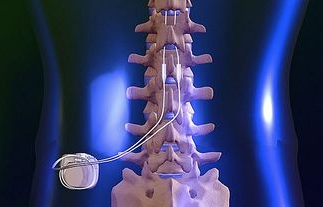Dr. Zachary T. Levine is a board certified neurosurgeon with extensive experience in functional neurosurgery. He has taught DBS courses and proctored other surgeons throughout the U.S. & Europe He has served on the Board of Governors for Parkinson’s Foundation of the National Capital Area and is seen as expert in frameless DBS by the industry. He patented a technique of transplanting cells into the brain for neurodegenerative disorders.
Neuromodulation
In general, Neuromodulation involves interfacing the nervous system with circuits or implanting catheters to deliver medication directly. This allows for direct treatment of a variety of neurologic problems including pain, spasticity from spinal cord injury, brain injury or multiple sclerosis, movement disorders and others. Neuro-modulation is a method of altering signaling of the nervous system to treat symptoms of a neurological disease or disorder. Conditions that are treated include a variety of movement disorders: Parkinson’s Disease, essential tremor, dystonia and Tourette’s Syndrome as well as some forms of chronic pain. Using implanted circuits, the symptoms of these disorders are diminished or in some cases completely alleviated. These implanted devices use electrical signals that can be controlled by the patient. Neuromodulation includes all forms of neurostimulation including Deep Brain Stimulation, Spinal Cord Stimulation, Peripheral Nerve Stimulation and Motor Cortex Stimulation as well as spinal pump delivery systems to treat spasticity. Neuro-modulation uses the most sophisticated technology to treat a variety of symptoms and Washington Brain & Spine Institute is seen as a leader in the field. Dr. Zachary Levine leads the team. He works with an experienced group of electrophysiologists and neurologists as well as pain management physicians to achieve the best results possible for our patients. The emphasis is on patient outcomes using a team approach.
Neuro-modulation Devices
All of the devices we implant are underneath the skin with no externalized parts. They are all battery operated and some are even rechargeable. Some act like pacemakers (pulse generators) sending impulses to the nervous system to achieve the desirable results. Often these devices can be controlled by the patient, allowing more or less stimulation based on the patient’s needs. All modification of the stimulator can be done with an external remote. Other devices infuse medications into the nervous system to achieve results. These pumps will have to be refilled periodically, but that can be done at the doctor’s office. The frequency of refilling varies with each patient’s needs. Whether its a pulse generator or a pump, these devices can be modified to suit the needs of the patient. The settings can be changed over time as symptoms change. Often these modifications can be done by the patient’s themselves.
Forms of Neuro-modulation
Neuro-modulation encompasses a wide array of devices to treat neurological disorders. These include Movement Disorders, Pain, and Spasticity. The type of device required to treat a given symptom or disorder varies as does the method of implantation. Some surgeries can be done as a simple out-patient procedure, others require an overnight stay in the hospital
DEEP BRAIN STIMULATION
DBS is used to treat a number of disorders. The most common disorders treated are Parkinson’s Disease and Essential Tremor. However, we have used DBS to treat stroke related and Multiple sclerosis associated tremor as well as dystonia, Tourette’s syndrome and intractable pain from stroke. With DBS a thin wire is precisely implanted in the brain and connected to a “pacemaker.” The pacemaker generates an electrical signal that diminishes or abolishes the symptoms of the disorder being treated. DBS requires an overnight stay in the hospital
SPINaL CORD STIMULATIoN
SCS typically is used to treat severe low back and leg pain. Even after successful spinal surgery for disk and spinal joint disorders, patients may be left with residual pain. This pain is often not well treated with typical pain medication. SCS can be implanted above the region of the surgery and the electrical impulses can diminish the pain. It has also be used to treat pain associated with poor blood flow in the legs and nerve damage from trauma or diabetes. This is usually done as an out-patient.
INTRATHECAL PUMP IMPLANTATION
Baclofen is a potent muscle relaxant used to treat spasticity. Spasticity is a disorder seen associated with multiple sclerosis or after spinal cord or brain injury, stroke, It is characterized by increased tone in the muscles and spasms. It can be quite painful and debilitating. With the implantation of a thin catheter and pump underneath the skin, liquid baclofen can be infused into the spine and help muscles relax, easing discomfort and make daily routines easier


